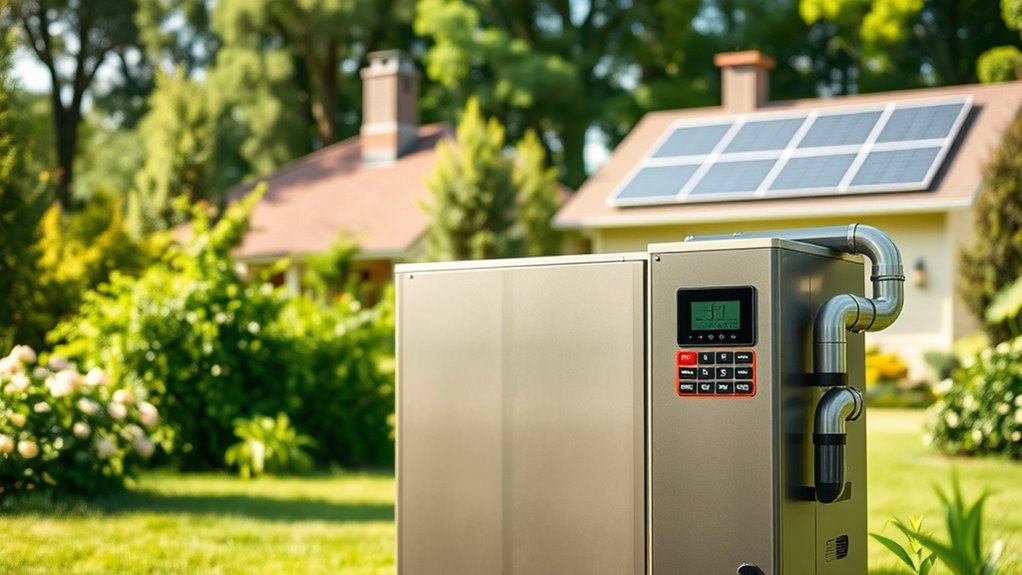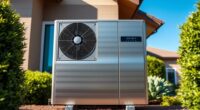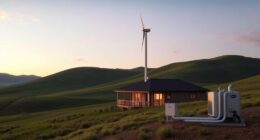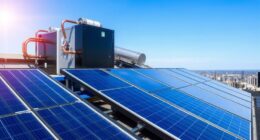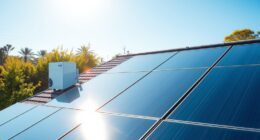To select an energy-efficient heat pump, focus on models with high SEER and HSPF ratings, ideally above 17 for cooling and 9 for heating, which indicate better efficiency. Confirm proper sizing based on your home’s size and climate, and consider professional assessments like Manual J calculations. Look for reliable brands with positive reviews and advanced features like smart sensors. Don’t forget about available incentives and rebates that can reduce costs. To learn more, explore how proper installation and maintenance maximize your system’s performance.
Key Takeaways
- Prioritize models with high SEER2 (14.3+ for split systems) and HSPF2 (7.5+), indicating better cooling and heating efficiency.
- Properly size your heat pump using Manual J calculations to prevent oversizing or undersizing issues.
- Consider climate and home insulation to select appropriate systems, such as air-source or geothermal, for optimal performance.
- Choose reputable brands with strong reviews, high efficiency ratings, and advanced features like smart sensors and variable speeds.
- Check for available rebates, tax credits, and incentives to reduce upfront costs and maximize long-term savings.
Understanding Heat Pump Efficiency Ratings and Standards
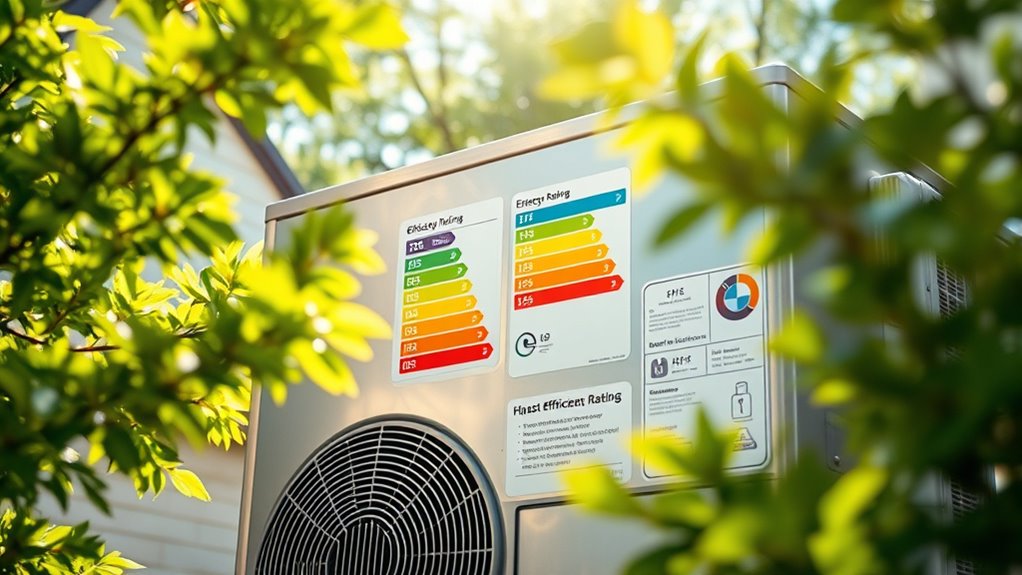
Understanding heat pump efficiency ratings and standards is essential to choosing a system that saves energy and reduces costs. SEER2 measures cooling efficiency based on real-world conditions, with highly efficient models rated 17 or higher. The minimum SEER2 for split-system heat pumps is 14.3, but newer testing includes fan power adjustments for a more accurate picture. HSPF2 evaluates heating efficiency, especially in colder temperatures, requiring a minimum of 7.5 and ideally 9.0 or above for peak performance. Other ratings like EER2 compare cooling efficiency under specific conditions, with minimums around 10.6 for single-packaged units. These standards guarantee you select a system that performs reliably while meeting energy efficiency regulations, which are updated to reflect real-world use. Energy efficiency standards are periodically revised to promote better performance and lower environmental impact, ensuring that consumers benefit from innovations in heat pump technology. Additionally, understanding the influence of wave and wind on coastal weather can be important when selecting a heat pump location to optimize its efficiency and longevity. Recognizing the impact of climate conditions on heat pump performance can help in choosing a system that maintains efficiency across seasonal variations. Staying informed about regional regulations and incentives can also help maximize savings and ensure compliance with local laws.
Properly Sizing Your Heat Pump for Optimal Performance
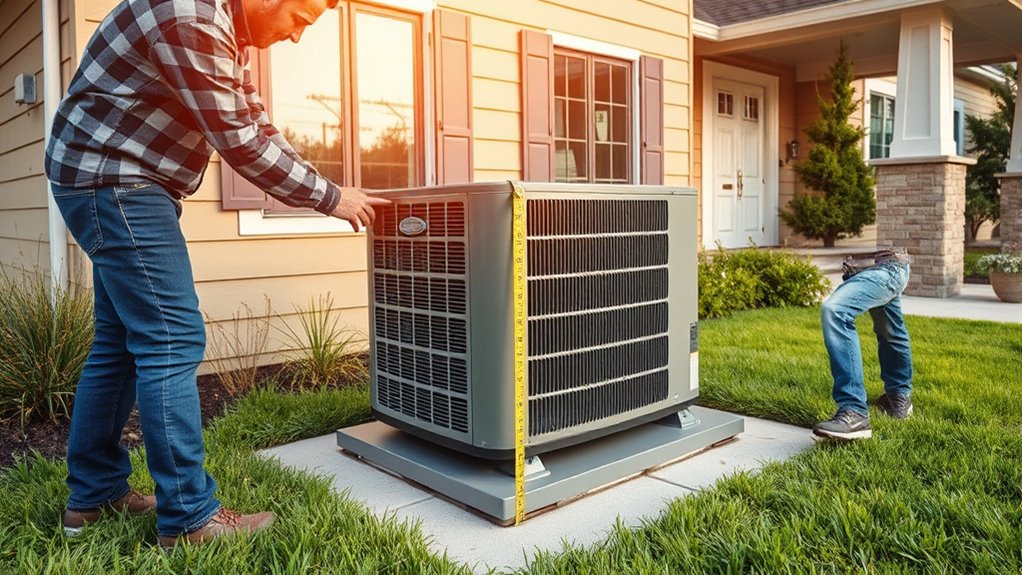
Choosing the right size for your heat pump is essential to guarantee it operates efficiently and keeps your home comfortable. To do this, consider factors beyond just square footage; a general rule is one ton of capacity per 500 square feet, but climate, insulation, and window placement also matter. Homes with better insulation or fewer windows require smaller units, while those in extreme climates need larger ones. Occupants, appliances, ceiling height, and air leaks influence heating and cooling loads too. Accurate sizing involves methods like Manual J calculations or consulting HVAC professionals who assess all these factors. Avoid oversizing, which wastes energy and shortens equipment life, or undersizing, which leads to discomfort. Proper assessment ensures your heat pump meets your home’s specific needs for maximum efficiency and comfort. Additionally, understanding the interior features and insulation levels of your home can further optimize your heat pump’s performance. Incorporating energy modeling techniques can provide a more precise sizing estimate tailored to your home’s unique characteristics. Utilizing advanced thermal analysis tools helps refine these calculations for even greater accuracy. Conducting a comprehensive load calculation is also vital to account for all unique energy demands of your home. Furthermore, considering Gold IRA principles like proper sizing and selection can serve as a metaphor for ensuring your heating system is a secure and optimal investment for your home’s long-term energy efficiency.
Exploring Different Types of Heat Pumps and Their Suitable Applications
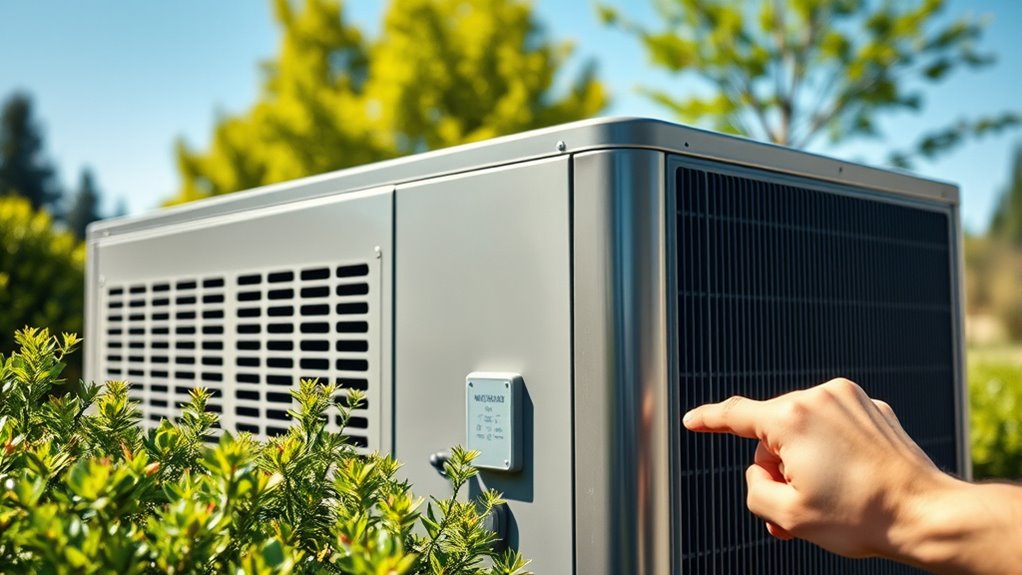
Selecting the right heat pump depends on your home’s specific needs and the environment where you live. If you want a straightforward option, an air-source heat pump efficiently transfers heat from outside air to inside, ideal for moderate climates. Geothermal heat pumps use underground water or ground loops, offering high efficiency but requiring specific site conditions and higher installation costs. They exploit stable underground temperatures, typically above 40°F in winter, which enhances their efficiency. Additionally, geothermal systems can provide both heating and cooling, making them versatile for year-round comfort. Ducted systems distribute heat through existing ductwork, suitable for homes with central HVAC systems, while ductless mini-split systems are perfect for zoned heating and cooling without ductwork. Hybrid heat pumps combine different heat sources to optimize performance, especially in varied climates. Your choice should consider installation complexity, available space, climate, and whether zoning flexibility or high efficiency is your priority. Understanding energy efficiency helps ensure you select a system that balances performance and operational costs effectively. Proper sizing and maintenance requirements also play a critical role in ensuring long-term efficiency and reliability. Incorporating self-directed IRA strategies can also be beneficial for financing energy-efficient upgrades through alternative investments, if applicable.
Evaluating Energy Savings and Economic Benefits of High-Efficiency Models
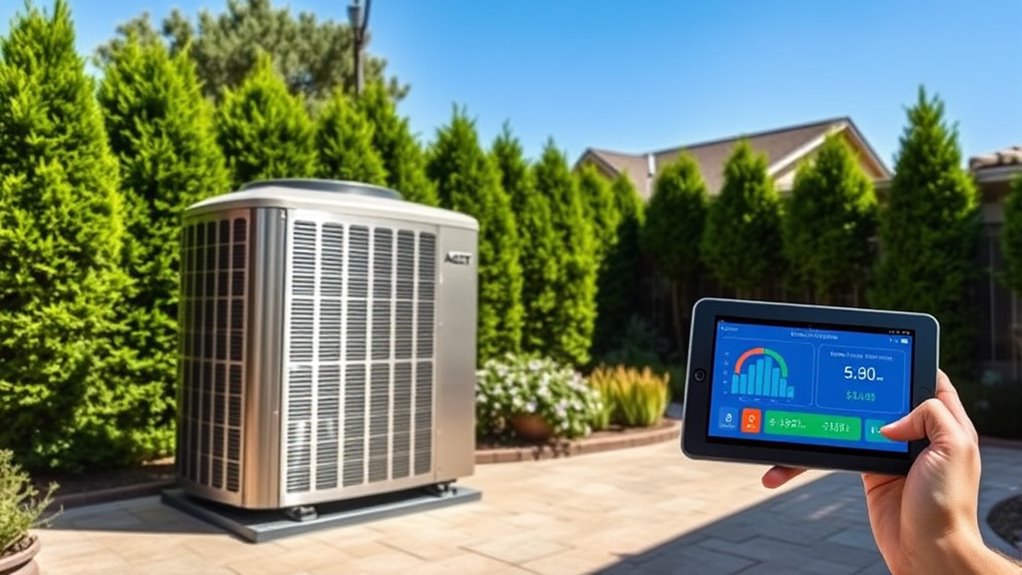
High-efficiency heat pumps offer significant economic advantages by reducing your home’s energy bills and increasing its value. These units typically have a seasonal COP of at least 3.5 and a SEER of 5.9 or higher, cutting energy use by 31% to 47%. They lower operational costs by improving heat transfer efficiency and decreasing fuel consumption. Additionally, replacing older systems with high-efficiency models can reduce carbon emissions by up to 7.6 tons annually. You may also qualify for tax credits up to $3,200 and benefit from various incentives that make the investment more affordable. Incorporating affiliate marketing strategies can help you find the best deals and options. Over time, the savings on utility bills and increased property value can offset initial costs, making high-efficiency heat pumps a smart choice for long-term economic and environmental benefits.
Ensuring Proper Installation and Routine Maintenance for Longevity

Proper installation and routine maintenance are essential to guarantee your heat pump performs efficiently and lasts for years. Start by ensuring the system is correctly sized through a Manual J load calculation, avoiding units that are too large or small, which can cause inefficiency. Work with licensed HVAC professionals who follow manufacturer specifications and standards like ACCA/RSES for installation, including proper ductwork, placement, and clearances. Regularly clean filters monthly, schedule coil cleaning every 6-12 months, and monitor refrigerant pressures annually. Inspect electrical connections for corrosion or looseness and document system performance. Proper refrigerant management, precise charging, and using low-loss fittings are vital. Additionally, using accurate sizing methods like Manual J ensures optimal system performance and energy efficiency. Regular maintenance also supports the hydrogen energy sector’s shift toward cleaner, more sustainable solutions by reducing energy waste. Implementing proper refrigerant management techniques not only enhances efficiency but also helps in complying with environmental regulations. Consistent maintenance keeps your heat pump running smoothly, saving energy and extending its lifespan.
Selecting the Right Brands and Models Based on Performance and Reviews
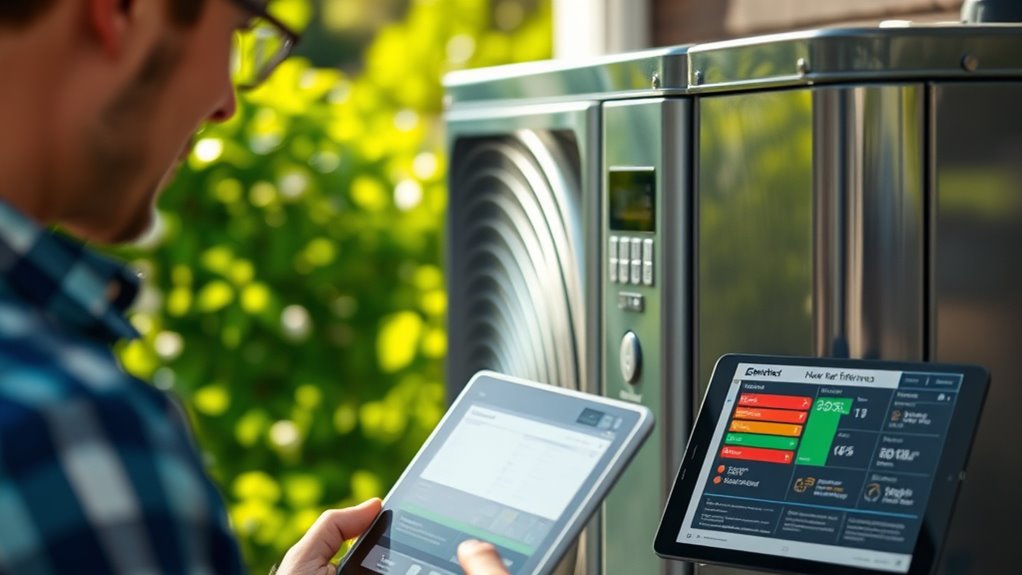
Choosing the right heat pump depends heavily on the brands and models that deliver reliable performance and positive reviews. Look for models with high SEER ratings (14 to 23+) and HSPF ratings up to 13, which indicate efficiency. Brands like Daikin excel with advanced features such as environmentally friendly refrigerants and smart sensors that optimize comfort. Mitsubishi Electric’s Hyper-Heating Inverter technology ensures efficient operation in cold climates, while Trane’s variable speed models boost energy savings. Customer feedback highlights Carrier and Trane for reliability, with Daikin praised for quiet operation and sustainability. Consider brands with strong service support and warranty coverage, like Mitsubishi. By focusing on performance ratings and customer reviews, you can choose a model that balances efficiency, durability, and value. Energy-efficient systems are increasingly popular for reducing utility bills and environmental impact. Additionally, selecting models with high performance ratings can help ensure long-term satisfaction and savings, especially when they incorporate advanced features that enhance overall operation.
Considering Incentives, Rebates, and Tax Credits to Maximize Savings
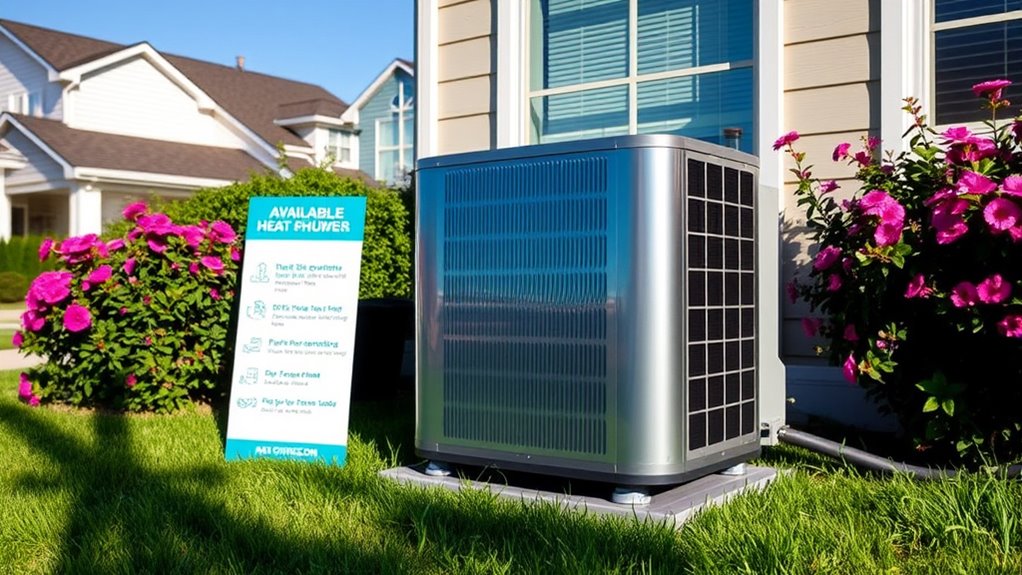
Maximizing your savings on a heat pump installation requires understanding and leveraging available incentives, rebates, and tax credits. Federal tax credits can cover up to $2,000 or 30% of your installation costs for high-efficiency models, with no income limits—just make sure your heat pump meets efficiency standards. State and local rebates vary and often target low- to moderate-income households, with some rebates up to $8,000, administered through state agencies or utilities. Combining these incentives can substantially cut costs, especially when coordinated with utility company rebates. Keep in mind, tax credits are claimed using IRS Form 5695 and are capped at $2,000 annually until 2032. Research local programs and plan your installation timing to maximize these benefits and reduce your overall investment. Be sure to verify eligibility requirements to ensure you qualify for the specific incentives available in your area. Understanding energy-efficient appliance standards can help you select the most qualifying models and optimize your savings. Additionally, being aware of program application deadlines can ensure you don’t miss out on valuable financial incentives. A thorough understanding of financial incentives can help you make more informed decisions throughout the process. For example, knowing about available rebates can help you strategize your purchase for maximum benefit. Moreover, understanding equipment efficiency standards can guide you in choosing models that qualify for the highest incentives.
Integrating Your Heat Pump Into Your Home’S HVAC System for Maximum Efficiency
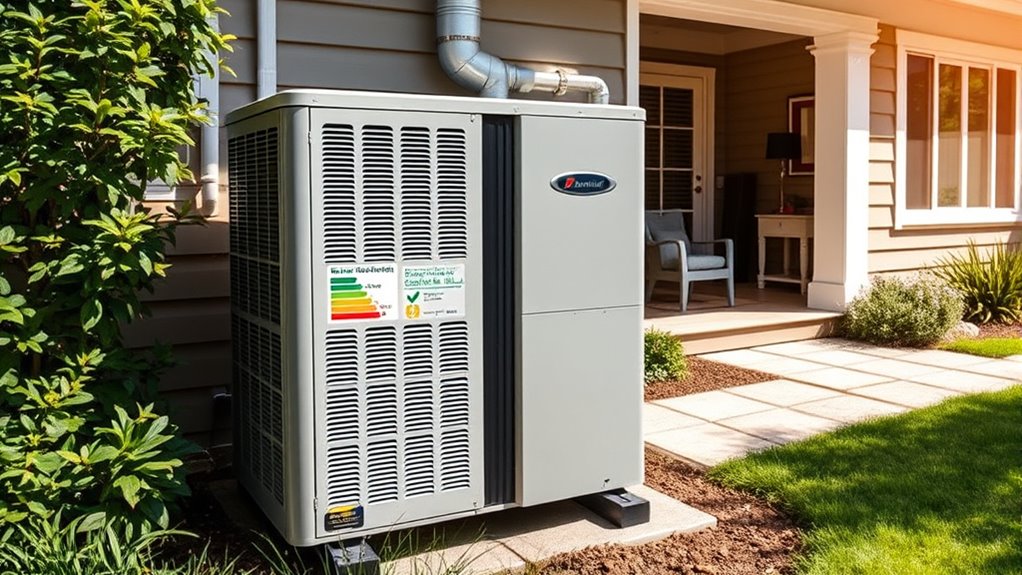
Integrating your heat pump into your home’s existing HVAC system is essential for achieving peak efficiency. Start by ensuring your ductwork is properly sized, sealed, and insulated to prevent heat loss, which can reduce efficiency by up to 30%. Use zoning systems with smart thermostats and dampers to direct airflow precisely, avoiding energy waste in unused areas. Synchronize controls like programmable thermostats to optimize temperature settings based on occupancy and weather patterns. Pair the heat pump with auxiliary heating systems, such as a gas furnace, for reliable comfort during cold snaps. Balance airflow by managing supply and return vents to maintain consistent indoor temperatures. Proper integration minimizes energy consumption, prolongs system lifespan, and maximizes your investment in an energy-efficient heat pump. Advances in cold climate technology also enable your heat pump to operate effectively even in colder temperatures, further enhancing overall efficiency. Additionally, ensuring proper system calibration can improve your heat pump’s performance and energy savings over time. Regular maintenance and attention to airflow management contribute to sustained efficiency and comfort. Incorporating heat transfer principles into your system design can further optimize heat flow and reduce energy use. Paying attention to current insulation levels in your home can also help maximize the benefits of your heat pump’s efficiency.
Frequently Asked Questions
How Does Climate Variability Affect Heat Pump Efficiency Over Time?
Climate variability impacts your heat pump’s efficiency over time by causing fluctuations in temperature, which challenge its performance. Extreme weather events like heatwaves or cold snaps make the system work harder, reducing efficiency. Changing weather patterns also alter energy demand, requiring your heat pump to operate more frequently or intensely. To maintain efficiency, you should consider climate-adapted models, regular maintenance, and advanced controls that help your system cope with these unpredictable conditions.
Can a Heat Pump Effectively Heat and Cool in Extremely Cold Climates?
They say, “A stitch in time saves nine,” and that’s true for cold-climate heat pumps. These units are designed to heat and cool effectively even in extremely cold climates, working down to -15°F with high efficiency. Modern models use advanced technology, enhanced compressors, and defrost controls to maintain performance. Just guarantee you select a unit rated for your region, and consider a backup system for the coldest days.
What Are the Long-Term Maintenance Costs Associated With Different Heat Pump Types?
You should consider the long-term maintenance costs for different heat pump types. Air-to-air systems cost about $100 to $300 annually for basic upkeep. Air-to-water units may need extra repairs for hydronic parts. Geothermal pumps have higher indoor component costs—$200 to $500 yearly—but underground loops last decades with minimal repairs. Regular maintenance extends lifespan and saves money, making geothermal systems the most cost-effective over time, despite higher initial costs.
How Do Smart Home Integrations Impact Heat Pump Energy Performance?
A stitch in time prevents nine, and smart home integrations boost your heat pump’s energy performance by optimizing operation based on your habits and environment. You can control and schedule settings remotely, monitor energy use, and enjoy personalized comfort. These features guarantee your system runs efficiently, reduces energy waste, and extends its lifespan. In the long run, smart tech helps you save money and reduce your carbon footprint, making your home smarter and greener.
Are There Specific Noise Level Considerations for Residential Heat Pump Models?
When selecting a residential heat pump, you should consider noise levels. Look for models with sound ratings around 40-50 dB, similar to a quiet conversation. Keep in mind that installation location impacts noise perception—placing units away from living spaces and using sound barriers helps. Regular maintenance and choosing models with advanced noise-reduction technology guarantee quieter operation, making your home more comfortable and less disruptive.
Conclusion
Choosing the right energy-efficient heat pump is like planting a seed for long-term savings and comfort. By understanding ratings, sizing correctly, and maintaining your system, you’ll guarantee it blossoms into a reliable, cost-effective solution. Don’t forget to explore rebates and integrate it seamlessly into your home’s HVAC. With these steps, your heat pump will work smoothly, turning your home into a cozy oasis while your energy bills stay grounded.
